This early 5.1 microphone technioque shoot-out gained a lot of knowledge and until now, these audio samples (nicely made up as a DVD-Audio) are useful to compare diffferent approaches.
During a Surround Sound Microphone Seminar at ORF (Austrian Broadcast, Vienna) in the year 2002, a comparison of seven main microphone setups (see below) for 5.1 Surround Sound was performed by a simultaneous recording with consecutive blindfolded listening tests. The Radio Symphony Orchestra Vienna played two different music samples.
DVD Download
The recorded tracks are available for download as a DVD image in order to repeat the blindfolded listening test.
This DVD enables to intuitively compare by switching between the streams using the "Audio"-button of the DVD player remote.
The DVD was produced by John Oag, formerly IRT.
Listening test
During the ORF Surround seminar and at an another later occasion the samples were compared in listening tests. The 18+14 participants had to assess different characteristics of these sound samples in a blind test. The results of these assessments are reproduced as mean values in 9 tables: Results of the Vienna and Düsseldorf Listening Tests
Listening test Vienna: Every setup was saved as a snapshot and then recalled according to a prepared order only known to the „master of ceremony“, Christian Sodl from ORF-Radio. One excerpt from the rehearsed works (Mozart + Berio), each approximately two minutes long was played with all seven systems. One complete test procedure therefore lasted about 40 minutes. 18 subjects (sound engineers) were divided into 6 testing groups (3 persons each). Each person could move around during listening.
A detailed paper about the listening test can be obtained here: F. Camerer: Classical Music in Radio and TV - a multichannel challenge
The Vienna test was performed by Florian Camerer and Christian Sodl, ORF. The diagrams were made by Helmut Wittek.
Details of the recording
Recording hall: Grosser Sendesaal (big transmission hall) of the Austrian Radio;{accordion} some more details about the recording ::
-
Orchestra: Radio Symphony Orchestra of the ORF (RSO Vienna);
-
Musical program: 1. W.A.Mozart: „Maurerische Trauermusik“ c-minor, KV 477
2. L.Berio: Concert for Trombone & Orchestra (the soloist was not present at the rehearsals);
-
Recording console AMS/Neve Capricorn;
-
Monitors: 2x Genelec 1034 for L + R; 3x Genelec 1037 for C, LS + RS; No subwoofer (we did not record an LFE)
-
Recording machines 2x SONY PCM 3324 DASH Multitrack recorders;
-
Setup and session proceeding: Christian SODL, executive sound engineer of ORF-Radio.
Microphone setups
The Decca-Tree and the Brauner ASM5 (an INA5 setup) were suspended right above the conductor at a height of 3,2m (the Decca-Tree a little bit higher at 4m with the center mic down 40cm). The Soundfield MKV was recessed 1m behind at the same height as the ASM5. Next came OCT at a height of 3.5m and 1.5m behind the conductor. Following in the line were the Stereo+C arrangement (2.5m behind and 4m above ground; the Center-omni 6m above ground) and the Schoeps KFM360 Surround as the furthermost system with a distance of 3.5m and a height of 3.6m. The Hamasaki Square was added to some configurations to reproduce the room information. The individual recordings were mixed and optimised according to taste by the relevant protagonists if present (Theile/Wittek for OCT and Gernemann for Stereo+C). The other systems were adjusted by participants with specific experience regarding one or the other system.
This table illustrates all systems:





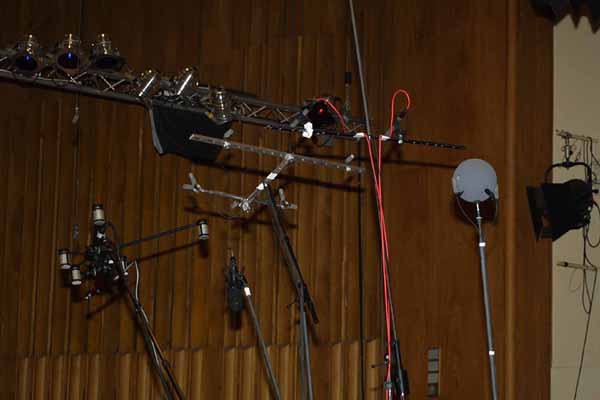
 (by A.Gernemann) This system is based on a "regular" main microphone for 2-channel stereophony like AB or MS with an additional omnidirectional microphone for the Center high above the main pair (>2m); As a result of the big distance the Center-signal is quite decorrelated with the main pair and can be used from barely noticable to being of the same level as L and R. The main reason for this solution is compatibility with non-ideal real-world listening room systems in people´s homes, where the Center speaker is often located beneath or above the TV-set and/or of inferior audio quality. A second point is the immediate backward compatibility with 2-channel stereo, even more interesting in times of tighter budgets. The microphones used were 2 Schoeps MK 2S omnis for L+R (AB) and one Schoeps MK 2H omni for C.As Surround setup we used the "Hamasaki Square".
(by A.Gernemann) This system is based on a "regular" main microphone for 2-channel stereophony like AB or MS with an additional omnidirectional microphone for the Center high above the main pair (>2m); As a result of the big distance the Center-signal is quite decorrelated with the main pair and can be used from barely noticable to being of the same level as L and R. The main reason for this solution is compatibility with non-ideal real-world listening room systems in people´s homes, where the Center speaker is often located beneath or above the TV-set and/or of inferior audio quality. A second point is the immediate backward compatibility with 2-channel stereo, even more interesting in times of tighter budgets. The microphones used were 2 Schoeps MK 2S omnis for L+R (AB) and one Schoeps MK 2H omni for C.As Surround setup we used the "Hamasaki Square".  ... or as we indicated it shortly just "NHK" after its inventor Kimio Hamasaki of the NHK Science and Research Laboratory. This consists of 4 fig-of-eight microphones (Schoeps CCM 8) arranged in a square of about 2m sidelenght, placed not to far behind the main microphone (about 5m), which has the advantage of a greatly reduced delay- or echo-problem with respect to the timing of the frontal pickup. The 4 fig-of-eight mics face the sidewalls of the hall and have therefore minimum direct sound pickup. The panning was as follows: the rear fig-of-eights were panned directly to Left Surround (LS) and Right Surround (RS) and the front fig-of-eights were panned half way between front and surround on each side respectively.
... or as we indicated it shortly just "NHK" after its inventor Kimio Hamasaki of the NHK Science and Research Laboratory. This consists of 4 fig-of-eight microphones (Schoeps CCM 8) arranged in a square of about 2m sidelenght, placed not to far behind the main microphone (about 5m), which has the advantage of a greatly reduced delay- or echo-problem with respect to the timing of the frontal pickup. The 4 fig-of-eight mics face the sidewalls of the hall and have therefore minimum direct sound pickup. The panning was as follows: the rear fig-of-eights were panned directly to Left Surround (LS) and Right Surround (RS) and the front fig-of-eights were panned half way between front and surround on each side respectively. 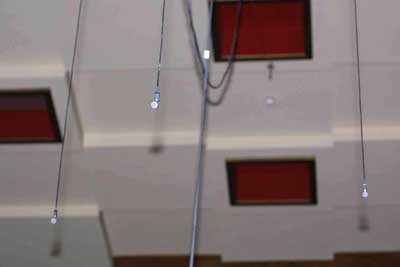 This well-known setup with three omnis (here Schoeps CCM 2S) is used as the standard configuration for the numerous recording sessions taking place in the "Grosser Sendesaal" of the ORF (base-length: 1.5m). The system was reinforced with two additional Schoeps CCM 2S omnis on the sides (3.5m), the so-called "out-riggers".
This well-known setup with three omnis (here Schoeps CCM 2S) is used as the standard configuration for the numerous recording sessions taking place in the "Grosser Sendesaal" of the ORF (base-length: 1.5m). The system was reinforced with two additional Schoeps CCM 2S omnis on the sides (3.5m), the so-called "out-riggers". 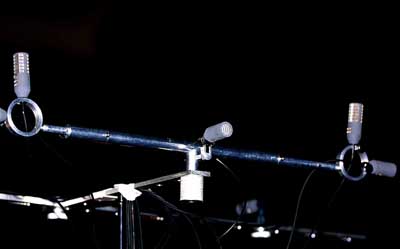 This system was devised by Günther Theile (details: Multichannel Natural Music Recording Based on Psychoacoustic Principles) and relies on unequivocal localization between the two stereo-bases L-C and R-C. Based on the localization theory, OCT chooses supercardioids facing 90° away from the orchestra for L and R (base distance b=70cm) and a cardioid facing forward for C closer to the orchestra (h=8cm). For example, a half-left signal is then mainly picked up by the left supercardioid and the central cardioid and has little enough crosstalk into the right supercardioid due to the fact that the signal reaches it in the minimum sensitivity-region of its polar-pattern. Therefore only L and C are relevant for the panorama position, resulting in a distinct localization. Special side-address supercardioids are used as their main pickup is from 90°, ensuring that the frequency response is equal to 0° frontal pickup, albeit with lower level. The somewhat poorer bass response due to construction principles is compensated with the addition of two omnis adjacent to the supercardioids which are lowpass-filtered at 100Hz to provide low-end down to 20Hz. The microphones used were from the Schoeps CCM series (two CCM 41V, one CCM 4 and two CCM 2S).
This system was devised by Günther Theile (details: Multichannel Natural Music Recording Based on Psychoacoustic Principles) and relies on unequivocal localization between the two stereo-bases L-C and R-C. Based on the localization theory, OCT chooses supercardioids facing 90° away from the orchestra for L and R (base distance b=70cm) and a cardioid facing forward for C closer to the orchestra (h=8cm). For example, a half-left signal is then mainly picked up by the left supercardioid and the central cardioid and has little enough crosstalk into the right supercardioid due to the fact that the signal reaches it in the minimum sensitivity-region of its polar-pattern. Therefore only L and C are relevant for the panorama position, resulting in a distinct localization. Special side-address supercardioids are used as their main pickup is from 90°, ensuring that the frequency response is equal to 0° frontal pickup, albeit with lower level. The somewhat poorer bass response due to construction principles is compensated with the addition of two omnis adjacent to the supercardioids which are lowpass-filtered at 100Hz to provide low-end down to 20Hz. The microphones used were from the Schoeps CCM series (two CCM 41V, one CCM 4 and two CCM 2S). 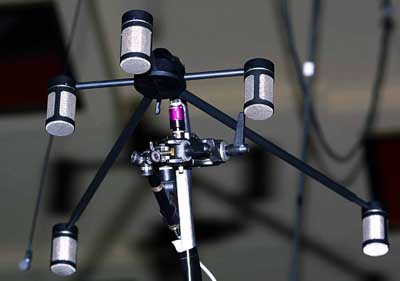 (Ideale Nieren-Anordnung = Ideal Cardioid Arrangement) after Herrmann /Henkels:
This system is based on the Williams localization curves, so that the recording angles of adjacent microphone pairs just touch each other. The German company SPL together with the microphone manufacturer Brauner developed a special crate with five arms with the respective microphones and a corresponding processor for remote powering and control of polar patterns, level ganging, LFE-split-up, 2-channel-downmix etc. (ASM5-Microphone + SPL Atmos-5.1-Processor).
(Ideale Nieren-Anordnung = Ideal Cardioid Arrangement) after Herrmann /Henkels:
This system is based on the Williams localization curves, so that the recording angles of adjacent microphone pairs just touch each other. The German company SPL together with the microphone manufacturer Brauner developed a special crate with five arms with the respective microphones and a corresponding processor for remote powering and control of polar patterns, level ganging, LFE-split-up, 2-channel-downmix etc. (ASM5-Microphone + SPL Atmos-5.1-Processor). 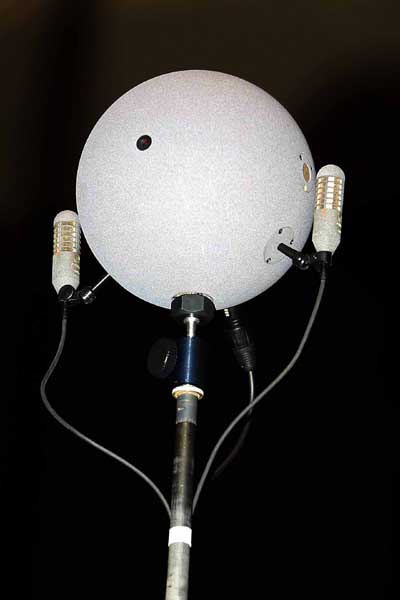 (after J.Bruck) A sphere microphone (SCHOEPS, after G.Theile) with smaller diameter than the original sphere is combined with the two figure-8 microphones aiming forward and closely mounted to the pressure transducers. By matrixing (sum and difference like MS-Stereo) the four channels are derived. An optional center-signal is derived through a special 2/3-matrix. All matrixing is done in a digital processor box, the Schoeps DSP4 KFM360.
(after J.Bruck) A sphere microphone (SCHOEPS, after G.Theile) with smaller diameter than the original sphere is combined with the two figure-8 microphones aiming forward and closely mounted to the pressure transducers. By matrixing (sum and difference like MS-Stereo) the four channels are derived. An optional center-signal is derived through a special 2/3-matrix. All matrixing is done in a digital processor box, the Schoeps DSP4 KFM360. 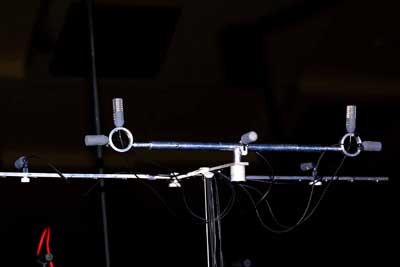 Instead of the Hamasaki-Square for the surround signals two cardioids (Schoeps CCM 4) are used right behind (50cm) the frontal OCT array and with a slightly extended base (100cm). The cardioids are oriented straight away from the orchestra (180°), so that their direct-signal-pickup is minimal.See also
Instead of the Hamasaki-Square for the surround signals two cardioids (Schoeps CCM 4) are used right behind (50cm) the frontal OCT array and with a slightly extended base (100cm). The cardioids are oriented straight away from the orchestra (180°), so that their direct-signal-pickup is minimal.See also 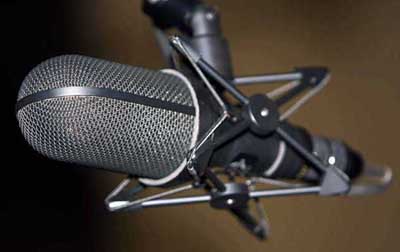 The Soundfield microphone captures the soundfield through a tetrahydral array of 4 (near-)cardioid capsules. The primary signals of those cardioids (also called A-Format) are then matrixed so that 4 new signals are created - called W, X, Y and Z or B-Format - representing 4 new characteristics: omni (W) and three fig-of-8s (X, Y, Z) perpendicular to each other. This B-Format-signal is recorded and during replay decoded through a suitable decoder to a desired loudspeaker-layout (many possibilities, theoretically limitless). The Soundfield microphone forms the practical basis of the Ambisonics system (after M. A. Gerzon) that can provide complete periphonic sound-reproduction. For 5.1 loudspeaker-setups the special decoder (B-Format to 5.1) required is called "Vienna"-decoder and the resulting speaker-feeds G-Format. The Soundfield company produces their own B-Format-to-5.1-converter, the SP451. It shall be noted that for horizontal reproduction the Z-channel is omitted.
The Soundfield microphone captures the soundfield through a tetrahydral array of 4 (near-)cardioid capsules. The primary signals of those cardioids (also called A-Format) are then matrixed so that 4 new signals are created - called W, X, Y and Z or B-Format - representing 4 new characteristics: omni (W) and three fig-of-8s (X, Y, Z) perpendicular to each other. This B-Format-signal is recorded and during replay decoded through a suitable decoder to a desired loudspeaker-layout (many possibilities, theoretically limitless). The Soundfield microphone forms the practical basis of the Ambisonics system (after M. A. Gerzon) that can provide complete periphonic sound-reproduction. For 5.1 loudspeaker-setups the special decoder (B-Format to 5.1) required is called "Vienna"-decoder and the resulting speaker-feeds G-Format. The Soundfield company produces their own B-Format-to-5.1-converter, the SP451. It shall be noted that for horizontal reproduction the Z-channel is omitted.